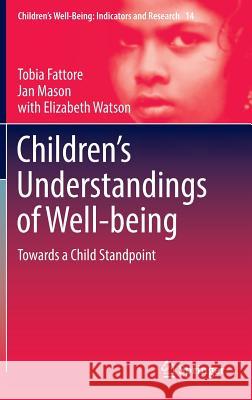Children's Understandings of Well-Being: Towards a Child Standpoint » książka
Children's Understandings of Well-Being: Towards a Child Standpoint
ISBN-13: 9789402408270 / Angielski / Twarda / 2016 / 280 str.
This book reports on the findings from a large, qualitative research project that set out to explore the views of children and young people across New South Wales, Australia on what constitutes their well-being. The research explores what meanings children and young people ascribe to the concept, and identifies key domains of well-being to be used to monitor the well-being of children, at a population level, throughout New South Wales (and beyond) in an ongoing way. The research was conducted by the New South Wales Commission for Children and Young People in collaboration with researchers from the Social Justice and Social Change Research Centre at the University of Western Sydney. The methodology for the project involved children as co-constructors of knowledge at the data gathering and analysis stages of the project. Central to this collaborative approach was the iterative nature of our engagement and dialogue with the children, before and during our research interactions with them. The research was conducted over three stages involving either individual or group interviews and employing a range of task-oriented methods. A total of 123 children from both rural and urban locations in New South Wales participated in the first stage of the research. Of these, 92 children contributed to stage two and 53 to the final stage. The children, when initially recruited to the project, were aged between eight and fifteen. Over the last 20 years there has been an increasing concern to measure children's health, welfare and well-being. Governments have responded to calls that early intervention and prevention have cost-benefits in the form of healthy, productive citizens and communities. As a consequence tertiary response and economic rationalist models of policy making are being moderated by well-being and primary prevention models. In parallel, the importance of children's participation, especially in decisions that affect their lives has been recognised and given impetus by the United Nations Convention on the Rights of the Child. Children are increasingly given a chance to express their ideas in various political forums, from the international to the local. Despite these shifts towards focussing on well-being and children's participation, very little research has drawn from both developments in endeavouring to find out what children think about what well-being means to them. Traditionally, adults have determined 'what's good for kids', where their best interests lie and what the priorities should be in policy areas of immediate concern to them. This research was unique in that it has documented children's views about what constitutes well-being for them, what makes them 'feel good'. Two underlying aspects founded children's discussion of well-being, emotional life and the significance of important relationships. These two factors provided a medium that children used to discuss what was important to well-being and allowed children to integrate complex and contradictory experiences into their understanding of well-being Beyond or, rather, building on this foundation, were three additional critical factors: first, having power to take assert agency, to make choices; secondly, a sense of security and safety; and, thirdly, a positive sense of themselves as people. These three fundamental elements inform other factors children say are important to children's well-being such as, responding to adversity, attitudes to and having material and economic resources, physical health, interaction with their environments and social and moral responsibilities. These findings have formed the basis for the final stage of the research - the development of indicators for monitoring children's well-being. They have promoted international interest in the research and in the outputs of the individual researchers. In a significant sense, the research can be described as comprising three outputs or sets of insights. The first, outlined above, is the detailed account of children's own understanding of what constitutes their well-being. This is essentially an ethnographic account: the findings reveal the meanings this group of children attach to well-being, how well-being is experienced in everyday life and what factors contribute to a sense of well-being. Epistemologically, it represents a body of knowledge which has been constructed from a children's standpoint, it sets out to give status to children's knowledge about and experience of their world and their place in it. The second contribution from this research is a reflection on methodology and method. How does one do research with children in a respectful and useful way and what have we learnt from our attempt to do so? The third contribution has proved to be the most demanding of the three - the attempt to develop indicators that are responsive to and reflect children's understanding of their well-being, or to specify elements that might be built into existing indicators so as to incorporate that understanding in the way the indicator measures well-being. The book will discuss all three contributions or outputs of the research but the principal focus is on the final set of findings. Each of the middle chapters will be devoted to one domain identified by children as crucial to their well-being and will explore this domain and the detailed meanings that children attached to it, drawing on the words and images they employed and placing the discussion within the relevant social science literature. The final chapters will reflect on the task of developing indicators based on these understandings.











